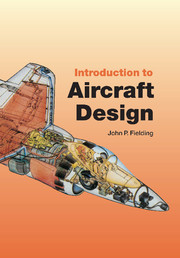Book contents
- Frontmatter
- Contents
- Preface
- Acknowledgements
- 1 Introduction
- 2 Why should we design a new aircraft?
- 3 Why is it that shape? – Civil aircraft
- 4 Why is it that shape? – Other types
- 5 What's under the skin? – Structure and propulsion
- 6 What's under the skin? – Airframe systems
- 7 What's under the skin? – Avionics, flight control and weapon systems
- 8 Why do aircraft cost so much?
- 9 What help can I get? – Bibliography and computer-aided design
- 10 The shape of things to come – Should the project continue?
- 11 What can go wrong? – Some lessons from past aircraft projects, and a glimpse into the future
- Appendix A Useful aircraft design data
- Appendix B A–90 parametric study. Example – the A-90 500-seat airliner
- Appendix C The prediction of aircraft reliability and maintainability targets
- References
- Index
6 - What's under the skin? – Airframe systems
- Frontmatter
- Contents
- Preface
- Acknowledgements
- 1 Introduction
- 2 Why should we design a new aircraft?
- 3 Why is it that shape? – Civil aircraft
- 4 Why is it that shape? – Other types
- 5 What's under the skin? – Structure and propulsion
- 6 What's under the skin? – Airframe systems
- 7 What's under the skin? – Avionics, flight control and weapon systems
- 8 Why do aircraft cost so much?
- 9 What help can I get? – Bibliography and computer-aided design
- 10 The shape of things to come – Should the project continue?
- 11 What can go wrong? – Some lessons from past aircraft projects, and a glimpse into the future
- Appendix A Useful aircraft design data
- Appendix B A–90 parametric study. Example – the A-90 500-seat airliner
- Appendix C The prediction of aircraft reliability and maintainability targets
- References
- Index
Summary
Secondary power systems
We have looked at an aircraft's primary power system, its propulsion, and will now examine its secondary power systems (SPS). Secondary power is usually provided by an aircraft's main engines when they are operating but can be supplied by other sources such as an auxiliary power unit (APU) in the aircraft or an external source on the ground.
Almost all present aircraft SPS are of three types, shown in Fig. 6.1.
Power is extracted from turbo-fan powerplants in two forms. Bleed air is tapped from one or more points along the engine compressor to provide pneumatic power. Drive shafts, from the engine's high pressure shaft, drive an accessory gear box on which are mounted generators and hydraulic pumps as well as the engine's own accessories. A typical large turbo-fan is shown in Fig. 5.13.
Turbo-jet powerplants can also supply bleed air and shaft power for systems, but turbo-prop powerplants in general have difficulty in supplying sufficient bleed air for airframe requirements. In such a case extraction of shaft power to drive separate compressors may be considered.
SPSs are often linked with each other, but it is convenient to separate them into the types described below.
Air-conditioning and pressurization
On many civil transports the largest amounts of secondary power are extracted in the form of bleed air and the largest continual user of this power is the aircraft's air-conditioning and pressurization system.
- Type
- Chapter
- Information
- Introduction to Aircraft Design , pp. 73 - 88Publisher: Cambridge University PressPrint publication year: 1999
- 1
- Cited by

